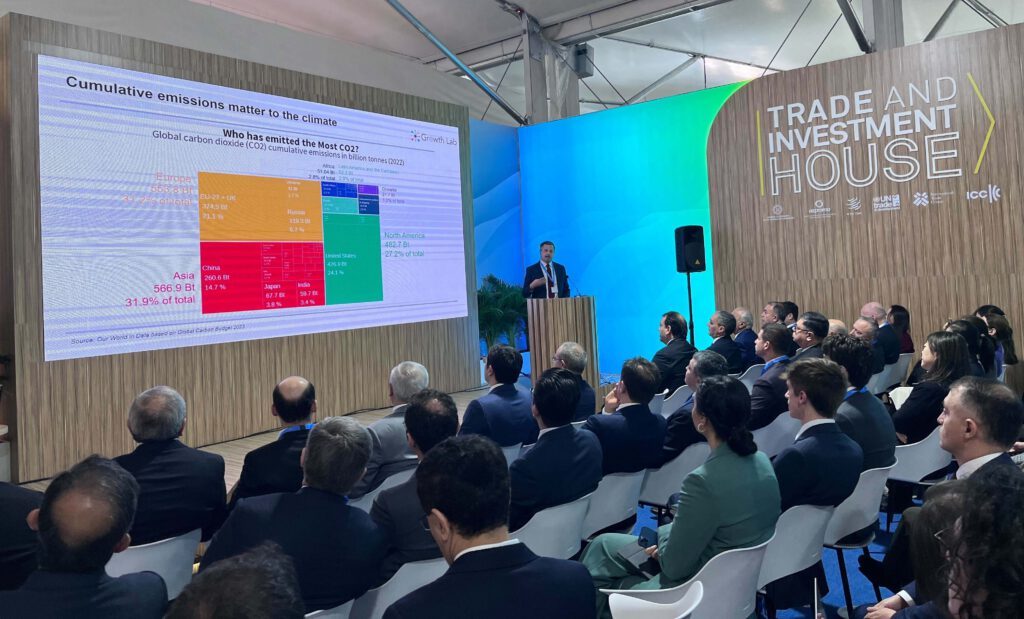Green Growth
Decarbonization will radically transform global production. It presents a defining opportunity for growth by creating new industries, markets, and paths to economic development.
For decarbonization to succeed globally, it should be reframed as a 21st-century update to John F. Kennedy’s appeal: “Ask not what your country can do to reduce its emissions; ask what your country can do to reduce the world’s emissions.”
Jump To
Overview
How Global Decarbonization Is Driving a Durable Opportunity for Economic Growth
The world is rapidly transitioning to a lower-carbon economy. Decarbonization will radically transform global production by creating new industries, markets, and paths for economic development. This energy transition presents a defining opportunity for growth by redefining the comparative advantage of places. Countries and regions must act quickly and adopt a context-specific strategy for green growth: places that act first to carve out their role in a rapidly greening world will come out ahead; others will be left behind.
As investors poured $500 billion into the energy transition last year alone, a new geography of energy is emerging. Fossil fuels such as coal and oil are energy dense and easy to transport. This has made the world ‘flat’ from an energy perspective, so countries with poor energy resources can specialize in energy-intensive production. Germany, Japan, China, and South Korea have therefore become the world’s top exporters of iron and steel.
Read More About Global Decarbonization
But decarbonization implies a move from cheap-to-transport fossil fuels to green sources of energy – sun, wind, hydro, and geothermal – that are unevenly distributed and only transported as far as the nearest electrical grid. The local availability of renewable energy will increasingly drive an economy’s comparative advantage. Places rich in hard-to-transport renewable power have a generational opportunity to produce energy-intensive building blocks of the world’s economy, such as ammonia, steel, aluminum, chemicals, and fuels. Countries that fail to pay attention to these changes may be left with ‘gray’ products that are increasingly shunned by a greening world, making national development more difficult.
Given that many of the world’s large economies are moving rapidly to decarbonize – and taking their financial backing with them – green growth presents a seismic, durable opportunity. Over the past half-century, successful economies have been able to evolve their comparative advantage, for example, by starting in garments before moving into electronics and machinery, shifting their industrial bases to create new jobs and higher incomes. Green Growth is no different: growth strategists must create methods to accrue new capabilities and exploit them to diversify their economies. Sometimes the best development pathways will involve using the green transition to gain new productive capabilities, which countries can then apply more broadly to other sectors of their economies.
As is too often the case with technological change, many places with the most to gain from the energy transition have been the slowest to adopt green growth strategies. Policymakers in these economies face multiple pressing priorities, from social unrest related to youth unemployment to the rising risks of a macro crisis amidst high global inflation. Against these problems, global climate change treaties that ask each country to reduce its carbon emissions seem like a distraction and an unfair one, given that climate change has been driven by advanced economies and will make economic progress harder for others. For countries as large as Turkey, Egypt, or Pakistan, which represent less than 1% of global emissions, achieving net zero emissions would not appreciably solve the world’s climate problem.
This framing misunderstands where the greatest gains are for many developing economies: not in restricting domestic emissions but in helping the world achieve a lower-carbon economy. For decarbonization to succeed globally, it should be reframed as a 21st-century update to John F. Kennedy’s appeal: “Ask not what your country can do to reduce its emissions; ask what your country can do to reduce the world’s emissions.”
Economic policymakers must consider how they can help the world reduce its emissions (and focus not just on their own carbon footprint) by promoting the right ecosystem for green growth. The green agenda may be about preventing a global catastrophe. But if managed well, policymakers have a chance to leverage it into the next great transformation of their economies.

Strategies
The Growth Lab is uniquely positioned to help countries develop green growth strategies. Over almost two decades, we have developed breakthrough insights into the nature of economic growth and applied our foundational research to projects with countries and regions around the world. The core of our approach relies on understanding how countries gain knowledge and productive capabilities and combine them in new ways to diversify their economies and connect with regional and international networks of trade. We aim to help policymakers assess locally appropriate strategies across several dimensions of green growth opportunities:
Explore our Five Strategies
- Producing the technologies and inputs for the world to decarbonize. Decarbonization will stimulate huge demand for new energy technologies. Supplying the booming demand for critical minerals, mineral processing, products in the value chains for technologies such as solar panels and batteries, and associated services is a smart green growth strategy. How close are these value chains to your productive capabilities? For key, unproven technologies, uncertainty remains around which technology will win out. Strategies will need to adapt to this shifting demand.
- “From grey to green”—producing energy-intensive activities in a green way. Some energy-intensive activities will need to relocate to places rich in cheap renewable power. Strategies must aim to leverage the relocation of these industries to stimulate growth. Producing these products with green energy will drive new comparative advantage to compete with ‘grey’ versions, may earn a green premium, and will serve markets that require purchasers committed to decarbonization. At the same time, large booms driven by investment into natural resources produce many distortions of a domestic economy. Countries must understand how these distortions play out and manage them in ways that favor inclusiveness, stability, and sustainability.
- Monetizing carbon sinks and carbon storage. Decarbonization will create whole new markets, such as the market for carbon credits. Certain natural landscapes hold enormous untapped value for use as carbon sinks. The challenge to making these landscapes pay is to create an enforceable, trusted carbon asset that can be traded abroad. Accessing high prices for carbon credits is key to monetizing natural landscapes. Elsewhere, carbon storage in geological formations holds the potential to relocate energy-intensive industries, creating dual opportunities for carbon storage and industrial production.
- Creating and exporting the knowhow for decarbonization. Places that lead in developing green industries can also export the knowhow for decarbonization to accelerate projects in other places. This applies to places leading on the research and development of new technologies, to leaders in financing capital investments, creating carbon markets, or developing supply chains for energy technologies. Exporting that knowhow can drive growth at home and help the world decarbonize.
- Applying capabilities gained from decarbonization to diversify into related productive areas. If pursued in the right way, decarbonization will require countries to generate new domestic capabilities that can be applied beyond green industries. Investments in decarbonization can act as a steppingstone to enter new production segments. This applies to using new capabilities learned from producing electrolyzers to enter other advanced manufacturing. Similarly, financing deployment of solar and wind may require countries to create more sophisticated financial markets that they can then apply to other financing challenges.
These approaches require very different capabilities and skillsets. Countries must develop a detailed understanding of their economic structure and map this structure to green growth opportunities to know which strategies they are best able to pursue. Some countries may have the geological profile, and technical expertise to export critical minerals or store captured carbon. Others may be able to manufacture needed products, such as power electronics, or components for electrolyzers and electric vehicles. Still, others may be wondering how to best exploit their renewable resources in their particular economic context. All countries will need to learn about the public goods they need to provide to develop their best opportunities, which often requires creating specific mechanisms that reveal this information. The Growth Lab is uniquely able to help countries approach these challenges.
Research Agenda
The Growth Lab has pioneered methods to understand how economies adopt new technologies to evolve their comparative advantage and achieve greater prosperity. These methods offer unique insights into how to design green growth strategies, leveraging a place’s existing capabilities to take advantage of context-specific opportunities. Core research is required to advance understanding of the nature of green growth opportunities to answer the following questions:
Read More About Our Research Agenda
- What are the value chains for clean energy technologies? Research will use network spaces to explore the value chains of a portfolio of clean energy technologies, from raw minerals to final assembly. Modelling work will study the viability of different technologies at different cost parameters.
- Which places have existing capabilities in clean energy technologies? What role do economies have in these spaces: mineral extraction, manufacturing assembly, or R&D centers? Research will use global trade, business location, and patent data to map the geographic presence, evolution, and co-location of key segments of clean energy technologies.
- How does a low-carbon future shift the landscape of demand for goods, energy sources, and technologies? How will clean energy technologies evolve, and which energy systems have the greatest technological risk? Research will map localized opportunities for places to play offense in growth industries where they have a comparative advantage. The research will also focus on strategies to play defense as the world prices out ‘dirty’ inputs, which must be made in green ways.
- How can places use their natural resources to diversify their economies? Research will map the potential of a place across clean energy resources and mineral deposits. This research will aim to assess the feasibility of mineral production and consider key institutions for investment in geological assets. The research aims to develop a framework for mineral extraction to build credibility and trust beyond the goal of maximizing the value of extractive rents.
- What public goods do countries need to pursue various green growth strategies: electrical grid infrastructure, financial markets, and access to export markets? Given that the sun shines for free and the cost of fixed capital partly determines project viability, this research aims to identify how places can reduce the cost of capital. Decarbonization also relies on massive amounts of R&D to come up with new ways to make products without emitting carbon (such as green steel) and to develop clean energy technologies. Research will study the necessary systems to stimulate R&D to drive innovation and access to technologies to lower emissions.
We aim to use these research findings in our executive education programs to train leaders around the world to pursue green growth effectively, in our applied projects advising countries on growth strategy, and in outreach activities to disseminate knowledge within the international community.

We aim to use our research findings in our executive education programs to train leaders around the world to pursue green growth effectively, in our applied projects advising countries on growth strategy, and in outreach activities to disseminate knowledge within the international community.
Course & Tool
Course
HKS Executive Education is offering a one-week on-campus program, Leading Green Growth: Economic Strategies for a Low-Carbon World. Under the direction of faculty chairs Ricardo Hausmann and Daniel Schrag, participants will gain a foundational understanding of decarbonization and its economic impact. In this video, Profs. Hausmann and Schrag share research insights and provide a preview of the course.
Tool

At COP29 in Baku, Azerbaijan, the Growth Lab launched Greenplexity, an interactive tool that helps countries identify their localized opportunities for green growth by supplying what the world needs for the global energy transition. The tool provides 10 years of data for ten green value chains: batteries, critical minerals, the electric grid, electric vehicles, green hydrogen, heat pumps, hydroelectric, nuclear, solar, and wind power, and includes strategic outlooks for more than 140 countries.
Related Research

Economic Prosperity in the Amazon Rainforest
Is there a tradeoff between environmental sustainability and economic development? Growth Lab researchers tackled this question and others in the Peruvian and Colombian Amazon.

Support Our Mission
We’re actively recruiting research fellows and postdoctoral fellows.




